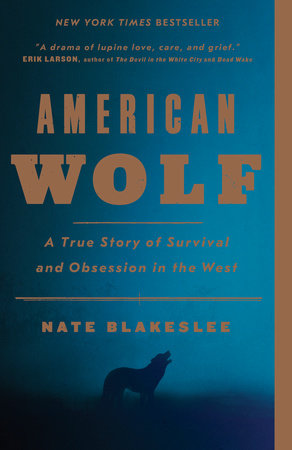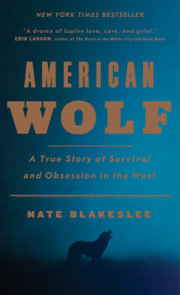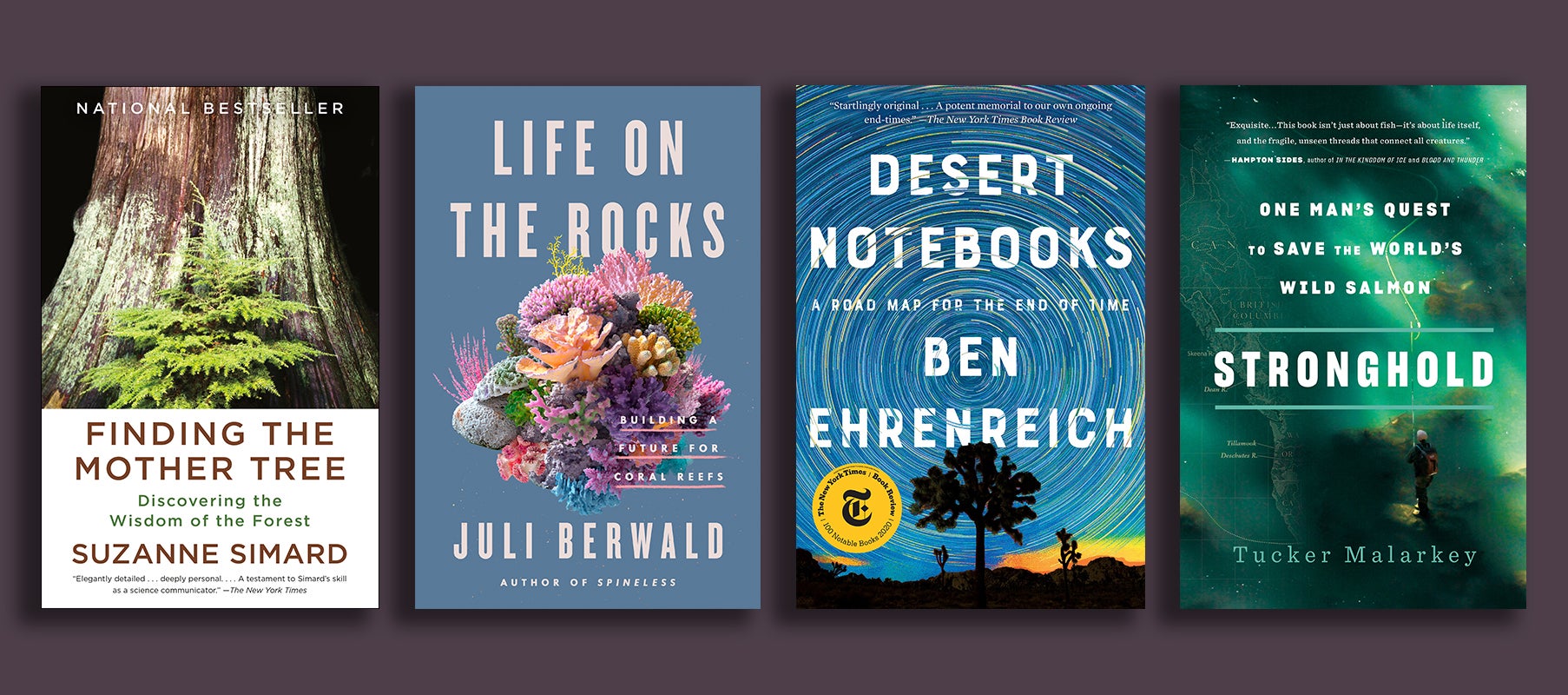1
Return of the Wolf
The wolves drove an elk down the side of a steep, snow-covered butte under a sky close and gray. There were three wolves. The one in the lead was almost pure white. She was followed closely by her sister, a good-size gray. Several yards back and struggling to keep up was a mature black male, his snout and withers gone silver with age.
The elk had been one of many cows atop the butte; now she was alone, hurtling pell-mell toward the broad valley below, dodging the lichen-covered glacial erratics—some the size of small cabins—that dotted the hillside, leaping over what she could, and exploding straight through the sage and juniper. It was early winter, and the snow was not yet deep, offering the kind of footing that favored the elk. For such an enormous animal—at least five times heavier than any of her pursuers—she was surprisingly fast and nimble. Her chocolate ears laid back against her head, her bouncing, ovoid rump the same shade of buff as the sedge poking up through the snow, she seemed an impossible quarry.
The cow headed for the river, as her kind often did when the wolves came. The deep water offered long-legged animals an advantage: a swimming wolf has no leverage for biting and pulling. Chases often ended in stalemate this way, with an elk standing in hip-deep water, warily eyeing a pack of wolves lounging on the nearby bank as they patiently waited to see if the frigid water would force the elk back onto dry land. The refuge the cow sought was the Lamar River, not far from where it joined the Yellowstone, and on this winter morning it was frozen solid. Perhaps she didn’t know that, or perhaps in her panic she could think of nowhere else to go.
It was only five hundred yards or so from the base of the butte to the river, but once the chase reached level ground, the wolves began to close the gap. The four animals were now in single file, running flat out, pounding the snow into a fine powdery spray, like the dust under a racehorse’s hooves. The contest had become purely a matter of speed, and the canines—the primordial ancestors of the greyhound, unsullied by the inbreeding that stripped away the tiger-muscled shoulders, the massive head, the powerful jaws—ran with a raw and joyous energy that the ungulate could not match.
As the race neared its climax, it was the gray who stood out. Her body seemed to stretch and elongate as the ground swept beneath her. Her legs were long—much longer than a dog’s—and her hips narrow, like a cheetah’s. She held her tail straight out, and her head was a flattened triangle. She was an arrow, and by comparison the elk suddenly seemed not only clumsy but also excessively—sadly, fatally—upright. Every time the cow missed a step, stumbling slightly in a pocket of deep snow, she had less time to recover, until finally there was no time at all.
The wolves pulled her down in a frozen marsh between two icy ponds.
About a quarter of a mile away, a man stood on the side of a road watching the wolves eat. His name was Rick McIntyre, and he worked for the National Park Service. Bundled in a heavy black down coat that extended past his waist, only the familiar forest green of his pants marked him as a park employee. He was in an area of Yellowstone known as Little America, where the Lamar River swept through a series of low hills and rocky knolls in the park’s mountainous Northern Range. Rick was sixty years old, though with his ramrod posture and tall, lean frame, his age was hard to guess, especially with a stocking cap covering his thinning red hair.
He was surveying the scene through a spotting scope, a kind of tripod-mounted telescope used for watching wildlife. Every so often he reached inside his coat and pulled a microcassette recorder from the breast pocket of his uniform and described what he was seeing. Just a few words, economical and to the point. Then the recorder disappeared back into the coat. For the most part, he stood motionless behind his scope, silently watching. It was nine a.m. on December 12, 2009, and it was the 3,467th day in a row that he had spent in the park, looking for wolves. It was getting close to lunchtime for Rick, who had been awake since about four that morning. The wolves were often active at dawn, and he liked to be in place when the landscape first became visible, about a half hour before actual sunrise.
Both the male and the white female in his scope, a mated pair, wore thick leather collars with radio transmitters attached, which was how he’d found them. Every pack in Yellowstone had at least one wolf that had been darted from a helicopter, collared, and assigned a number by the park’s small team of wolf biologists. Each morning Rick drove until the antenna on the roof of his yellow Nissan SUV picked up a wolf’s unique signal, and then he stepped out into the darkness to scan the nearby landscape with his handheld receiver.
As he watched the trio of wolves tugging at the elk carcass, Rick found his eye drawn back to the gray female. She had no collar, which meant she had not been given a number, but she did have a nickname: O-Six, for the year in which she had been born. At this range, his scope revealed every detail; she might as well have been sitting at his feet. She was a wonderful specimen, with a dense coat and a heavier physique than most females, who averaged around ninety pounds.
Not much usually distinguished one black wolf from another, but every gray was different. O-Six had unusually attractive markings—a faint black oval around each eye, offset by twin wedges of white along the bridge of her nose. Her cheeks were also white, and an unbroken streak of gray ran from the tip of her head to the end of her nose, tapering off into buff along the sides of her snout. The overall effect was of a vaguely owl-like mask, which gave her a look of quiet concentration.
She had been born a member of the Agate Creek Pack, in a den about five miles to the south, not far from where Agate Creek spilled into the chossy, sulfurous canyon that held the Yellowstone River. After leaving her pack as a yearling, she had been more or less on the run for the last two years, looking for a mate and a territory of her own.
So far she had been unsuccessful. Rick had observed her mating with five different males the previous winter without settling down with any of them, which was unusual behavior for a lone female. It was also hazardous. Young wolves had to leave their natal packs in order to find a mate, but outside their home territory, alone, they were in constant danger. Almost every part of Yellowstone’s landscape belonged to one pack or another, and the various tribes patrolled their holdings relentlessly. Lone wolves caught trespassing could count on being chased, and entire packs occasionally clashed with one another, especially along the borders of adjoining territories. Territorial conflict was the most common cause of death for the park’s wolves, most of whom didn’t live beyond four or five years. Life for wolves was an adventure, but it was usually not a long one.
At three and a half, O-Six had already reached middle age. Unless she found a mate soon, her prospects for survival were not good. Had she been a male, it might have been different; young males unable to find a mate were sometimes accepted into other packs. Such subordinate males were generally not allowed to breed—only the alpha male had that privilege—but they at least had a chance to take over from an aging alpha one day. Packs usually had just a single breeding female, the alpha, who tended to reject any newcomer who might bear pups of her own. Few lone wolves of either gender ever found what they were seeking: they either returned to their natal pack or died alone far from home.
Yet O-Six had a knack for not getting caught, and her moxie had made her one of Rick’s favorites. In recent months, she’d been tagging along with the collared pair in his scope—one of whom was her older sister and the other an unrelated male—as they hunted the outer reaches of Agate territory, pushing farther and farther north in search of unclaimed habitat.
It was an arrangement unlikely to last. O-Six was an outstanding hunter, which made her an asset to her companions, but there wasn’t much in the deal for her. Once her sister had pups with her new mate in the spring, she would be the alpha female of their new pack. O-Six would have to defer to her in every regard for as long as she remained healthy and fit to breed. Rick couldn’t imagine it. O-Six simply didn’t fit the mold of the beta female, content to wait her turn for a chance to lead and to have pups of her own. She didn’t have the temperament for it.
O-Six’s great-grandmother had been one of the first wolves reintroduced to the park, captured on the plains of western Canada, eight hundred miles to the north, and ferried south by plane and truck in the winter of 1995. By that time, Yellowstone had been essentially devoid of wolves for almost seven decades. Once found in virtually every habitat between the Arctic Circle and present-day Mexico City, gray wolves had been the target of a centuries-long campaign of trapping and poisoning—a war waged both for their valuable pelts and to protect livestock. They were all but eliminated by the 1920s across the vast majority of the Lower 48.
The last wolves believed to have been born in Yellowstone—a pair of pups discovered near Soda Butte Creek, about fifteen miles east of where Rick was now standing—were shot in 1926. They were killed not by poachers, but by park rangers. Almost from the time the park was created, in 1872, early superintendents had pursued a rigorous predator-control program, aimed chiefly at protecting the big game animals—elk, deer, moose, and bighorn sheep—that were considered Yellowstone’s prime attractions. Rangers patrolling on horseback finished the job the trappers had started: finding active dens, destroying the pups, and then trapping or tracking the returning adults so they could be killed as well.
As a science, wildlife management was still in its infancy, and park officials genuinely believed that predators would eventually decimate the park’s prey population if left to their own devices. They didn’t realize that wolves and elk had coexisted in Yellowstone for thousands of years, that the two species had in fact evolved in tandem with each other—which explained why the elk could run just as fast as the wolf but no faster. Wolves were the driving force behind the evolution of a wide variety of prey species in North America after the last ice age, literally molding the natural world around them. The massive size of the moose, the nimbleness of the white-tailed deer, the uncanny balance of the bighorn sheep—the architect of these and countless other marvels was the wolf.
Nor did Yellowstone’s early managers understand what would happen to an ecosystem without predators. Once the wolves were gone, the ungulate population in the park exploded, and the quality of the range quickly began to deteriorate. Overgrazed hillsides eroded, and stream banks denuded of woody shrubs began to crumble, damaging prime trout habitat. Elk browsing at their leisure, undisturbed by predators, decimated stands of young aspen and willow. Too many animals on the landscape brought starvation and disease, and the elk population followed a boom-and-bust cycle.
By the 1930s, Yellowstone officials had no choice but to do what they had done with the wolves. They started quietly culling the park’s enormous elk herds, shooting thousands of animals in an average year (usually in the winter, when few visitors were around to see the carnage). This continued until the 1960s, when hunters in areas adjacent to the park pressured their elected officials to intervene. Fewer elk in Yellowstone, they knew, meant fewer elk migrating out of the park in winter, which in turn meant fewer hunting opportunities. The elk population was once again allowed to grow untrammeled.
The idea that wolves might be the solution to Yellowstone’s problems surfaced as early as 1940, though it wasn’t until the 1970s that the federal government began seriously considering reintroduction. Elected officials in Idaho, Wyoming, and Montana (the states surrounding the park) were adamantly opposed to the idea, in deference to two constituencies that exercised an outsize influence on local politics: ranchers and hunters. Ranchers, whose own ancestors had helped rid the mountains of predators in the first place, feared they’d lose livestock once the reintroduced wolves began spreading beyond the park’s boundaries. Elk-hunters, meanwhile, knew the wolves would be subsisting on the same game they cherished—and they’d only just won the fight to keep rangers from reducing elk numbers. From the hunters’ perspective, every elk taken by a wolf was a lost opportunity, and wolves ate a lot of elk.
Hunting was big business in the Northern Rockies—not just for the professional hunting guides who relied on a steady stream of clients to earn a living, but also for the restaurants and motels that hosted the influx of out-of-town hunters who arrived every fall. As an endangered species, wolves would be protected even when they weren’t in Yellowstone, but in order to get the states on board, the U.S. Fish and Wildlife Service had made a promise: as soon as the reintroduced wolf population was sufficiently numerous and stable, the wolf would be taken off the endangered species list, and the states could manage their individual populations however they wished. It was understood that this would eventually mean an annual hunting season for wolves. Still, opponents of reintroduction fought literally to the very last minute, delaying the opening of the wolves’ cages as a federal judge considered their final pleadings.
In the end, proponents of reintroduction won, and the wolves were released in the park with great fanfare. Interior Secretary Bruce Babbitt and Fish and Wildlife Service director Mollie Beattie personally helped carry the cages the final stretch through the deep January snow to the release point. The Yellowstone wolves were fitted with radio collars and initially set loose into three acclimation pens, each about an acre in size. Project leaders hoped the period of adjustment afforded by the pens would make it less likely that the wolves would take off for home once they were set free. The truth was, nobody really knew what would happen. No one had ever tried this before.
Copyright © 2017 by Nate Blakeslee. All rights reserved. No part of this excerpt may be reproduced or reprinted without permission in writing from the publisher.







